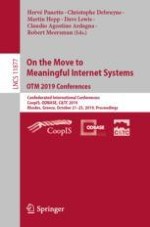2019 | Buch
On the Move to Meaningful Internet Systems: OTM 2019 Conferences
Confederated International Conferences: CoopIS, ODBASE, C&TC 2019, Rhodes, Greece, October 21–25, 2019, Proceedings
herausgegeben von: Hervé Panetto, Christophe Debruyne, Martin Hepp, Dave Lewis, Dr. Claudio Agostino Ardagna, Robert Meersman
Verlag: Springer International Publishing
Buchreihe : Lecture Notes in Computer Science
